
NGC 1818 is a young globular cluster in the north-west part of the Large Magellanic Cloud, about 3.2 kpc from the center. It was discovered by Scottish astronomer James Dunlop in 1826, and has since been well studied.

NGC 5986 is a globular cluster of stars in the southern constellation of Lupus, located at a distance of approximately 34 kilolight-years from the Sun. It was discovered by Scottish astronomer James Dunlop on May 10, 1826. John L. E. Dreyer described it as, "a remarkable object, a globular cluster, very bright, large, round, very gradually brighter middle, stars of 13th to 15th magnitude". Its prograde–retrograde orbit through the Milky Way galaxy is considered irregular and highly eccentric. It has a mean heliocentric radial velocity of +100 km/s. The galacto-centric distance is 17 kly (5.2 kpc), which puts it in the galaxy's inner halo.

NGC 6522 is a globular cluster in the constellation Sagittarius. It is apparent magnitude 8.3, and diameter 16.4 arc minutes, and class VI with stars 16th magnitude and dimmer. It was discovered by William Herschel on June 24, 1784. It is centered in a region of the sky known as Baade's Window.

NGC 6760 is a globular cluster in the constellation Aquila. It may have contributed to the formation of the open cluster Ruprecht 127 during NGC 6760's passage through the galactic disk 71 million years ago.

NGC 6934 is a globular cluster of stars in the northern constellation of Delphinus, about 52 kilolight-years distant from the Sun. It was discovered by the German-born astronomer William Herschel on 24 September 1785. The cluster is following a highly eccentric orbit through the Milky Way along an orbital plane that is inclined by 73° to the galactic plane. It may share a common dynamic origin with NGC 5466. As of 2018, it has been poorly studied.

NGC 2808 is a globular cluster in the constellation Carina. The cluster currently belongs to the Milky Way, although it was likely stolen from a dwarf galaxy that collided with the Milky Way. NGC 2808 is one of our home galaxy's most massive clusters, containing more than a million stars. It is estimated to be 12.5-billion years old.
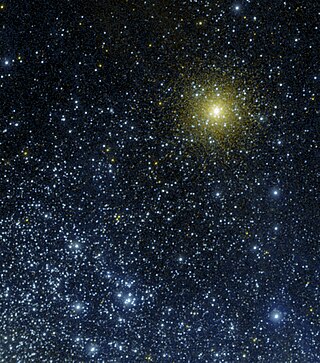
NGC 362 is a globular cluster located in the constellation Tucana in the Southern Hemisphere, slightly north of the Small Magellanic Cloud, to which it is completely unrelated. It was discovered on August 1, 1826, by James Dunlop. It is visible to the naked eye in dark skies, and is an impressive sight in a telescope, although it is somewhat overshadowed by its larger and brighter neighbour 47 Tucanae.
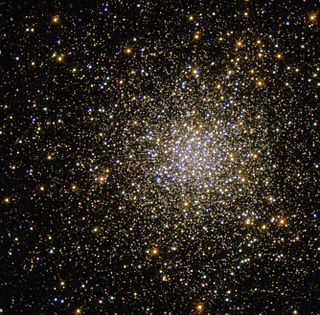
NGC 5694 is a globular cluster in the constellation Hydra. It was discovered in 1784 by William Herschel.
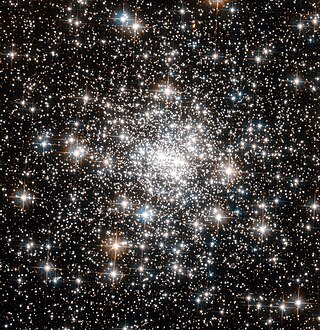
NGC 6642 is a globular cluster located 26,700 light-years from Earth, in the constellation Sagittarius. Many "blue stragglers" have been spotted in this globular, and it is known to be lacking in low-mass stars.

NGC 6304 is a globular cluster in the constellation Ophiuchus. William Herschel discovered this star cluster using an 18.5-inch (47 cm) f/13 speculum reflector telescope in 1786. It is about 19,000 light-years away, near the Milky Way's central bulge.

NGC 6139 is a globular cluster of the Milky Way in the constellation Scorpius. It is located 3.6 kiloparsecs from the Galactic Center.

NGC 6144 is a globular cluster in the constellation Scorpius, located almost exactly 1° away from its brighter counterpart globular cluster Messier 4. It is relatively close to and is partially obscured by the Rho Ophiuchi cloud complex. The cluster has a very low core stellar density for a globular cluster and harbors a handful of X-ray radiation sources.

NGC 121 is a globular cluster of stars in the southern constellation of Tucana. It is the oldest globular cluster in the Small Magellanic Cloud (SMC), which is a dwarf satellite galaxy of the Milky Way. This cluster was first discovered by English astronomer John Herschel on September 20, 1835. The compiler of the New General Catalogue, Danish astronomer John Louis Emil Dreyer, described this object as "pretty bright, pretty small, little extended, very gradually brighter middle". The cluster is located at a distance of around 200,000 light-years (60 kpc) from the Sun.

NGC 6380 is a globular cluster located in the constellation Scorpius. It was originally discovered by James Dunlop in 1826, and he named it Dun 538. Eight years later, in 1834, it was independently rediscovered by John Herschel and he named it H 3688. The cluster was re-rediscovered in 1959 by Paris Pişmiş, who catalogued it as Tonantzintla 1 — and referred to it as Pişmiş 25. Until the 1950s NGC 6380 was thought to be an open cluster. It was A. D. Thackeray who realised that it was in fact a globular cluster. Nowadays, this cluster is reliably recognised in widely available catalogues as a globular cluster, and referred to simply as NGC 6380.
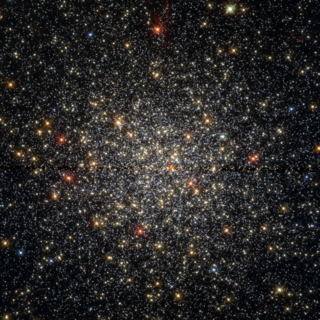
NGC 5927 is a globular cluster in the constellation Lupus. NGC 5927 has a diameter of about 12 arcminutes and an apparent magnitude of +8.86. Its Shapley–Sawyer Concentration Class is VIII, and it contains stars of magnitude 15 and dimmer.
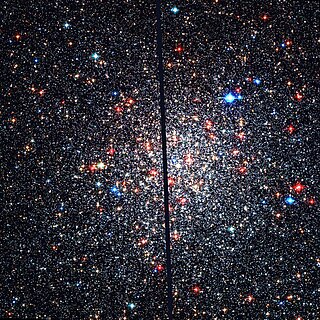
NGC 6553 is a globular cluster in the constellation Sagittarius. NGC 6553 has an apparent magnitude of about 8th magnitude with an apparent diameter of 8.2 arcminutes. Its Shapley–Sawyer Concentration Class is XI, meaning the star concentration is very loose even at the center; it has stars of magnitude 20 and dimmer. It is located just over a degree southeast of Messier 8, the Lagoon Nebula.

NGC 6528 is a globular cluster in the constellation Sagittarius, and is listed in the New General Catalogue. It has an apparent magnitude of about 11 and a diameter of about 16 arcminutes, and its Shapley-Sawyer Concentration Class is V, containing stars of 16th magnitude and dimmer. Dreyer described it as "pF, cS, R", meaning poor and faint, considerably small and round.

NGC 2108 is a globular cluster located in the constellation of Dorado. NGC 2108 was discovered in 1835 by John Herschel.

NGC 1898 is a globular cluster in the constellation of Dorado at an approximate distance of 170,000 light-years. NGC 1898 is located in the Large Magellanic Cloud, a satellite galaxy of the Milky Way, and was for some time believed to be discovered by John Herschel in 1834; however recent research shows it was first observed by James Dunlop in 1826.

NGC 7492 is a globular cluster in the constellation Aquarius. It was discovered by the astronomer William Herschel on September 20, 1786. It resides in the outskirts of the Milky Way, about 80,000 light-years away, more than twice the distance between the Sun and the center of the galaxy, and is a benchmark member of the outer galactic halo. The cluster is immersed in, but does not kinematically belong to, the Sagittarius Stream.




















